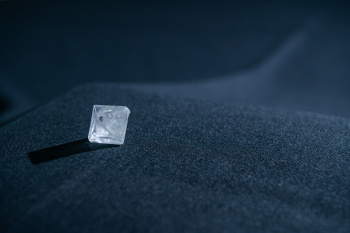Posted by Oliphant Science Awards
on 01/06/2022

by Ian McMahon
The first article in the blog focussed on two of the principal factors that can affect the success of growing award winning crystals. These were the quality of the solute, alum – how pure is it? and the quality of the solvent, water - again related to its purity.
The third factor which is central to the growing phase is control of temperature. From the outset, there is no foolproof procedure that perfectly controls the effects of changing temperatures particularly when you are not with your crystal growing solution(s). However there are steps that can be taken to reduce the problems with varying temperatures.
Alum crystals become larger the slower the solution cools.
With alum (as with any other crystal growing substance), your water must be supersaturated with the solute for crystals to grow. This means you must dissolve as much of the alum into your water as possible. Any methods you read suggest to perform the dissolving in warm water. Solutes like alum dissolve faster in warm water, so this is better since you will have more potential crystal building material in a given volume.
Simply add the suggested amount of alum perhaps one spoonful at a time into the warm water and stir vigorously until it disappears. When the alum no longer disappears and instead settles on the bottom of your jar, the water is supersaturated and ready to go.
Time constraints
Growing large, good quality crystals requires some patience (including restarts from scratch). The exercise may take many weeks maybe a school term to get optimal size and quality from the quantities given. Attempts to speed up the process by using a warm or a ventilated site to enhance evaporation rate may cause problems with crystal quality or spontaneous seeding like the original step where a supersaturated solution is made with the purpose of choosing seed crystals.
The data in the table shows the solubility of alum at different temperatures.
|
Temperature of 100g water (oC) |
0 |
10 |
20 |
40 |
50 |
60 |
70 |
80 |
|
Mass of alum dissolved (g) |
5.7 |
8.5 |
12.03 |
25.0 |
36.78 |
58.5 |
94.38 |
195 |
Using a moderate temperature for dissolving alum to prepare a supersaturated solution is advised (my reading of a number of procedures suggests for school and home-based crystal growers that hot water of 60-70oC would dissolve sufficient alum to prepare a useful supersaturated solution. It is also safer than boiling water.
The exact amount of alum will vary depending on the water temperature but it will be about 15 g/25 mL.
Differences between crystal growing in schools or at home
Sometimes home-grown crystals are more successfully grown than in the school environment. Usually the reason would be better management of the temperatures in the surroundings during the growing phase of the crystal (can be monitored daily).
Cover cooling saturated solutions with filter/kitchen paper or perforated alfoil – no dust allowed.
A relatively constant temperature over the days and weeks of growing the crystal(s) is very important.
As the SA competition happens during autumn moving towards winter, the responses in schools and at home will be haphazard. If, as might happen in a school lab, heaters may not be used in the day but are auto switched on overnight, then that nice crystal you were nurturing has disappeared because the solution was warmed and no longer saturated so the crystal has dissolved back into the solution.
In the past, schools with successful student-grown crystals have had the aid of an incubator to provide that constant environment. If not available, I have read that placing the crystal growing containers inside polystyrene foam or other insulated containers also counters the problem reasonably well and would apply equally well to home-grown crystals. A thermostated water bath has also been successful.
Handling of solid crystals during growing phase and after completion
– some ‘first aid’ that you can try but be careful!
The seed crystal(s) that you choose from your cooled original supersaturated solution should be small.
Do not touch the crystal during these days – hopefully it is growing visibly
If you observe that your big crystal has small crystals attached to its surface, you may carefully remove it and dry with tissues, and dislodge the small crystals [NO FINGERS!]
The time period that you may want your crystal to grow may vary between 3 & 7 weeks (not quick is it?)
If the crystal has not grown for a few days, it may need a new saturated solution prepared. Please ensure that this new solution is at room temperature or your crystal will start to dissolve.
What if your crystal gets smaller or disappears – start again!
It is important for most solution methods that the glassware be thoroughly clean. Note that new glassware often has dusty contaminants, so it must be thoroughly cleaned especially before the first use.
If a sample only yields small crystals, the method should be altered so as to slow down the growth step. Slowing the crystal growth sometimes requires changing the method used to grow the crystals.
Avoid vibrations near your growing crystals as this reduces the potential crystal size and quality.
If other crystals appear on the bottom or sides of the container during the growth period, remove the crystals (if careful) or better, pour the solution into another clean container then put the crystal in.
The problem of dust or other particles contaminating your growing solution is that such particles act as nuclei around which many small crystals are formed. This is not wanted – they are in competition with your crystal for the alum coming out of solution. You may need to start again.
In summary, monitoring and controlling temperature at various stages can be crucial. Preparing useful supersaturated solutions with sufficiently hot water, ensuring that such solutions are definitely at room temperature (in the place where the growing will happen) before adding seed crystal(s), and maintaining as much of a constant temperature zone daily will go a long way to growing a great crystal.
Please remember size is not everything – you need your crystal to be clear, have sharp edges and flat faces to be considered for a SASTA award.
In this Section
Archive
- December 2025
- November 2025
- October 2025
- September 2025
- August 2025
- July 2025
- June 2025
- May 2025
- April 2025
- March 2025
- February 2025
- January 2025
- December 2024
- November 2024
- October 2024
- September 2024
- August 2024
- July 2024
- June 2024
- May 2024
- April 2024
- March 2024
- February 2024
- December 2023
- November 2023
- October 2023
- September 2023
- July 2023
- June 2023
- May 2023
- April 2023
- March 2023
- February 2023
- January 2023
- December 2022
- November 2022
- October 2022
- August 2022
- July 2022
- June 2022
- May 2022
- April 2022
- March 2022
- February 2022
- January 2022
- December 2021
- November 2021
- October 2021
- September 2021
- August 2021
- July 2021
- June 2021
- May 2021
- April 2021
- March 2021
- February 2021
- January 2021
- December 2020
- November 2020
- October 2020
- September 2020
- August 2020
- July 2020
- June 2020
- May 2020
- April 2020
- October 2018
- September 2018
- August 2018
- July 2018

